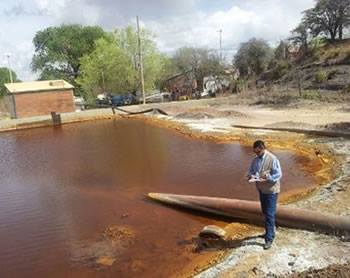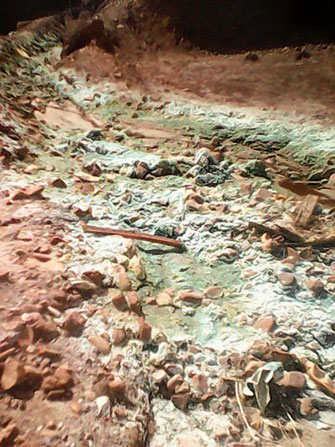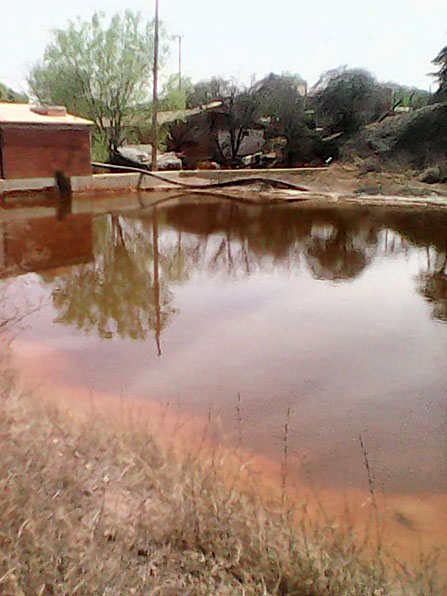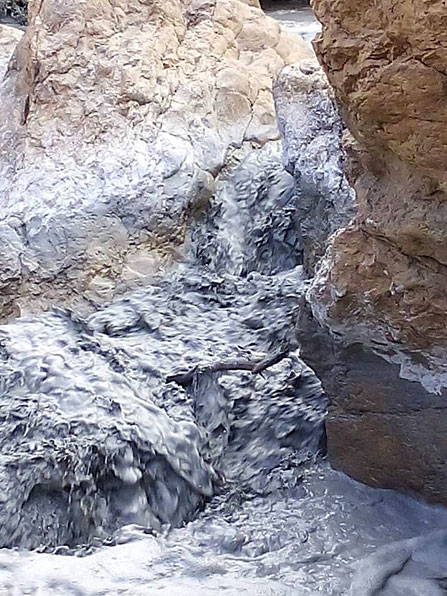After unleashing the country's worst environmental disaster, mining company Grupo México goes unpunished
CANANEA
A toxic chemical spill from Grupo Mexico’s Buenavista del Cobre mine in northern Sonora that released 10.6 million gallons of copper sulfate into the Bacanuchi and Sonora Rivers has been labeled as “ the worst environmental mining disaster” in the country’s history.
Authorities determined that the company had delayed more than 24 hours before publicly releasing news of the spill, and ordered the company to create a US$150-million trust fund for indemnification of damages caused.
Juan José Guerra Abud, director of the Ministry of the Environment and Natural Resources at the time, stated that the company publicly insisted the accident was caused by “greater than normal precipitation,” but the National Meteorological Service says that that is not the case. He says that the spill was due to the failure of a badly designed pipe at the mine.
The spill into Arroyo Tinajas occurred on Aug. 6, 2014. On Aug. 7, residents notified Sonora’s Civil Protection Agency. According to national press stories, the company notified the federal authorities on the 8th, but it wasn’t until four days later that they did so formally.
The lack of potable water, as well as cases of burns and even cancer, have affected entire families. Life has been made a living hell as people are unable to work or engage in their accustomed activities, or to trust the water or anything that they produce.
Cananea has been the most affected city, where the contamination is still quite evident and the incidence of childhood cancer is much higher. Here, the air, water, and soil are all contaminated.
On March 10, 2016, the Buenavista del Cobre mine had another spill that flowed into the Cananea Ejido. Francisco Lara, ejido president, notified the appropriate authorities.
The only person to show up identified himself as a “representative of the Federal Attorney for Environmental Protection” (Profepa).
News about the spill took several days to reach Hermosillo, there was no official follow-up, and Buenavista del Cobre Mine has never issued any comment.
El Jaralito, a small waterfall that was a source of clean, fresh water as well as being a popular recreation spot for many families in the city is now quite contaminated.
There is also a new river composed of leachate that originates in the storage ponds at the ESDE* plant, where all the acids (solvents) used by the mine are stored. Sodium hydrosulfide (NaSH, also known as sodium bisulfide) is used in the process and is a harsh irritant that can cause severe health and environmental problems. Prolonged contact with it can cause upper respiratory tract irritation.
Rivers of toxic waste pass a mere 200 yards from the city. At night, between 11 pm and midnight, the aroma of rotten eggs makes it difficult to breath and burns the nose. This is the hour when toxic chemicals are released at the mine and residents near the area know to close themselves indoors to reduce the effects.
Incidents have continued to occur. Cananea is surrounded by contamination from this monstrous mine. The rivers and waterfalls here are under constant threat, and are becoming scarcer because the mine company has a total disregard for any kind of life. Watch video by Jorge Herrera.
In spite of these terrible occurrences, according to an announcement published in the Federal Official Register (June 8, 2016), Arvayo Spring, site of the headwaters of the Río Sonora, is slated to be awarded to this mining company. The river’s water will also become property of the company, and no authority, institution or official will be able to do anything whatsoever to stop it.
The mine is currently expanding in order to increase its production. It has built new leachate ponds and, according to the mine’s employees, a future spill can’t be ruled out because of the potential risk of liquefaction of the retention pond walls by the contaminated water.
As of May 28, 2016, the business has prohibited its employees from using cell phones within the mine facilities. This has lead to a great deal of public unrest: If an accident were to occur, the workers wouldn’t be able to warn anyone, and this could cost the lives and health of the residents.
Additionally, all of the mine’s entrances and exits are heavily guarded by armed federal police who are authorized to use force at their own discretion.
Neighboring ranchers are clearly unhappy because the company doesn’t respect their ejido lands or roads. It opens and closes roads as it likes without notifying them beforehand.
Grupo México has a long history of tragedies across the country. In 2006, an explosion caused by a buildup of methane gas buried workers in the Pasta de Conchos Mine in Coahuila.
Only two of the 65 bodies were ever recovered from the mine. The National Commission on Human Rights issued a recommendation in which it confirmed that the mine did not have adequate security measures in place.
In June 2010, police violently raided and cleared a union encampment where 80 mine workers from Local 65 of the National Union of Miners, Metalworkers and Allied Workers of the Republic of Mexico had been on strike since 2007, demanding better working conditions.
Almost simultaneously, the Pasta de Conchos Mine was raided in order to silence protests held there by family members of the miners who had been trapped in the mine explosion in 2006.
Grupo México, under the leadership of Germán Larrea, is the world’s third largest producer of copper. According to Forbes Magazine’s 2013 rankings, Larrea is the third richest Mexican, with a net worth of around $13 billion.

Profepa inspecting the river.
This company has a dubious past because of all of the cases in which it has been implicated, not only in Mexico but in Peru, the United States, and Spain.
In the United States, it has been fined several million dollars for alleged fraud in the purchase of a mine in Tucson, Arizona. It was also ordered to pay more than $168 million to remediate environmental problems about which it had been warned, but had ignored. If the company doesn’t remediate the problems, the mine could be closed.
In Spain the company was accused of bribing a judge in order to obtain the concession to the Aznalcóllar Mine. “It doesn’t make any sense that the Aznalcóllar Mine should be given to the same company responsible for having caused one of the worst environmental disasters in Mexico and that then tried to cover it up,” points out Juan López de Uralde, one of the country's environmental icons and leader of the emergent Equo Party.
In Peru, the company is involved in a controversy over the release of an audio recording between an anti-mining activist and a company lawyer, in which the leader addresses the possibility of asking the company to pay him in exchange for ending the protests against the construction of the Tia María copper mine. The mine is a project of Southern Copper Company, principal subsidiary of Grupo México.
ESDE* - Solvent Extraction by Electrolytic Deposition Unit [Go back]
Sodium hydrosulfide (NaSH), according to the product label.
The greatest danger posed by this product is through exposure to hydrogen sulfide gas which it releases. It is an severe irritant and prolonged exposure can cause burns. Inhalation of NaHS flakes can cause irritation of the upper respiratory tract.
- Mixing with water — head aches, nausea, vomiting, irritation of the respiratory and digestive tracts, irritation of mucus membranes and even loss of consciousness.
- Contact of liquid with skin — Causes severe irritation and may cause chemical burns. Prolonged exposure may lead to dermatitis.
- Contact of liquid with eyes — Causes severe irritation and possible permanent corneal damage that results in blurry vision or even blindness.
- Ingestion — Severe burns and corrosion of all portions of the gastrointestinal tract, pain in the throat and stomach, nausea, uncontrollable vomiting, and diarrhea. In the most severe cases, total collapse, loss of consciousness, and respiratory paralysis may occur. Contact with stomach acid releases the highly toxic hydrogen sulfide gas.
- Environmental risks — Can be dangerous to aquatic life if released into water bodies. The product reacts with air and can cause fires when hydrogen sulfide gas is released.
- Special product risks — The product should not be mixed with acids because hydrogen sulfide gas is immediately released, with rapid, lethal effects.
Information corroborated by Dr. Reina Castro Longoria, researcher at the University of Sonora.



